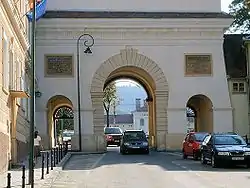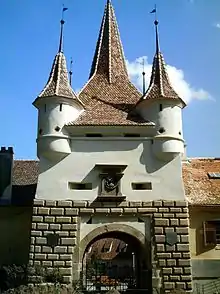Șcheii Brașovului
Șcheii Brașovului (Hungarian: Bolgárszeg, German: Belgerei or more recently Obere Vorstadt; traditional Romanian name: Bulgărimea, colloquially Șchei) is the old ethnically Bulgarian and Romanian neighborhood of Brașov, a city in southeastern Transylvania, Romania.

This village-like section of the town is mostly made up of small houses built along narrow roads with gardens and small fields on the slopes of the Tâmpa Mountain.
History
Until the 17th century, the inhabitants of Șchei were forbidden from owning property inside the city walls. The people living in the Șchei could only enter the town at certain times and had to pay a toll at the Catherine's Gate for the privilege of selling their produce inside the town. Catherine's Gate was the only entrance for the Romanians — they were not allowed to use the other four entrances, such as the Șchei Gate. It was in Șchei that Brașov's first Romanian School was established, next to the Romanian Orthodox church of St. Nicholas.
Researchers maintain the Șchei were ethnic Bulgarians who later adopted the Romanian language and ethnic identity.[1] The neighborhood's name has been recorded through the ages as follows: Bolgarszek (1611), Scheu Brașovului, orașul Schei lângă Cetatea Brașovolui (1700), Bolgarsek, Șchei de lângă Brașov (1701), Șchiiaii Brașovului (1708), Bolgaria Brașovului (1723), Șchei lângă cetate Brașovului unde-i zic Bolgara, Șchiai (1724), obștea din Bolgarseghi (1773), sărăcimea obștii Bolgarsegului (1774), Bolgarsec, Biserica Bolgarseghiului (1813), Bolgarsechi (1816), Bolgarsăchiu (1817), etc.[2]
According to Radu Tempea's Istoria besérecei Șchéilor Brașovului manuscript of 1899, the Bulgarians arrived in Brașov in the late 14th century, more exactly 1392. Their arrival is linked to the reconstruction of the Black Church, which had been destroyed by the Tatars in the 13th century, the reconstruction beginning 1385.[3]
The beginning of the construction of this neighbourhood dates according to all information that I can find to the 14th century, in which the city church began to be built in 1385. Because there was a lack of enough craftsmen for this important construction due to the Burzenland markets and villages being busy with the building of their churches and castles at the time and not being able to provide enough workers except for the supply of stones, so the people of Kronstadt were forced to let workers from the neighbouring provinces come into the city. For this reason came from Bulgaria the so-called by us Belger, who, in part because of the long work on the church construction, in part because they liked the successful times here, settled here as residents, at the place we still call the Belgerei, by the good work of the laudable Magistrate.[4]
By the beginning of the 19th century, the Bulgarian population of Șcheii Brașovului had been gradually Romanianized. An 1829 statistic on the population of Bolgárszeg, which stated the neighbourhood had a population of 5,829, did include Bulgari ("Bulgarians") in the list along with Valachi ("Romanians"), but noted no people of that ethnicity.[5]
Notable people
- Ioan Bogdan (1864–1919), linguist, historian, philologist
- Allen Coliban (1979–), mayor of Brașov
See also
Gallery

 Typical street in Șcheii Brașovului
Typical street in Șcheii Brașovului


 Solomon Cliffs (Pietrele lui Solomon) in Șcheii Brașovului
Solomon Cliffs (Pietrele lui Solomon) in Șcheii Brașovului Waterfall at Solomon Cliffs
Waterfall at Solomon Cliffs
References
- Милетич, Любомир (1896). "Брашов и брашовските българите ("шкеи", bolgárszeg)". Дако-ромънитѣ и тѣхната славянска писменость. Часть II (in Bulgarian). София: Сборникъ за Народни Умотворения, Наука и Книжнина.
- Coriolan Suciu, Dicționar istoric al localităților din Transilvania, vol. I, București 1967, p. 102.
- Heinz Heltmann, Gustav Servatius, Reiseführer Siebenbürgen, Thaur bei Innsbruck 1993, pp. 365.
- Thomas Tartler und Josef Trausch, Collectanea zu einer Geschichte v. Kronstadt. Original text in German:
"Den ersten Anfang des Anbanes dieser Vorstadt setzen alle Nachrichten, die ich finde, in die Zeit des 14 Seculi, in welchem die hiesige Stadkirche 1385 gebauet za werden anfing. Da es nämlich bei diesem wichtigen Bau an genugsamen Handleuthen aus iler Ursache fehlte, weil die Burzenländer Märkte und Dörfer zu gleicher Zeit mit Erbauung ihrer Kirchen und Schlösser beschäftigt waren and daher ausser der Zufuhr der Steine nicht zulängliche Arbeiter an die Stadt abgeben konnten: so waren die Kronstädter genöthigt, sich aus den benachbarten Provinzen Arbeitsleute kommen zu lassen. Auf diese Veranlassung kammen aus Bulgarien die von uns sogenannten Belger hieher, welche theils wegen der Langwierigkeit des Kirchenbaues, theils wegen der damaligen hier sehr wohlfeilen Zeit sich gefallen liessen, an diesem Orte, welchen wir noch die Belgerey nennen, mit Vergünstigung des löblichen Magistrates sich wohnhaft niederzulassen." - Милетич, p. 19.
